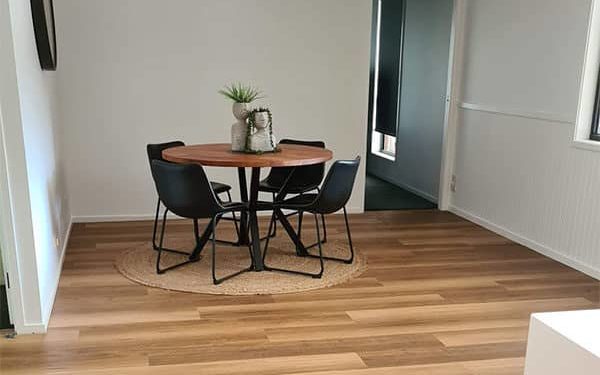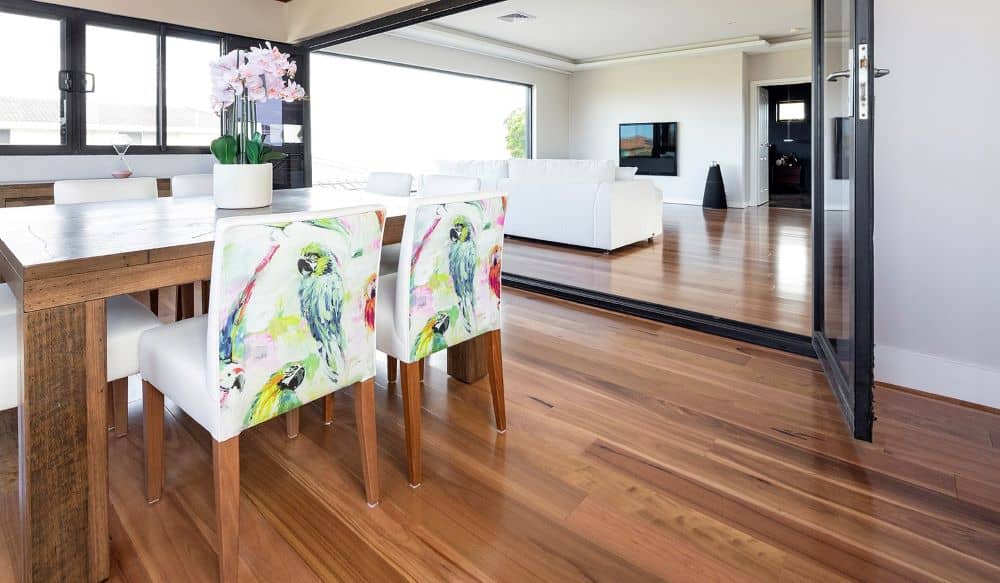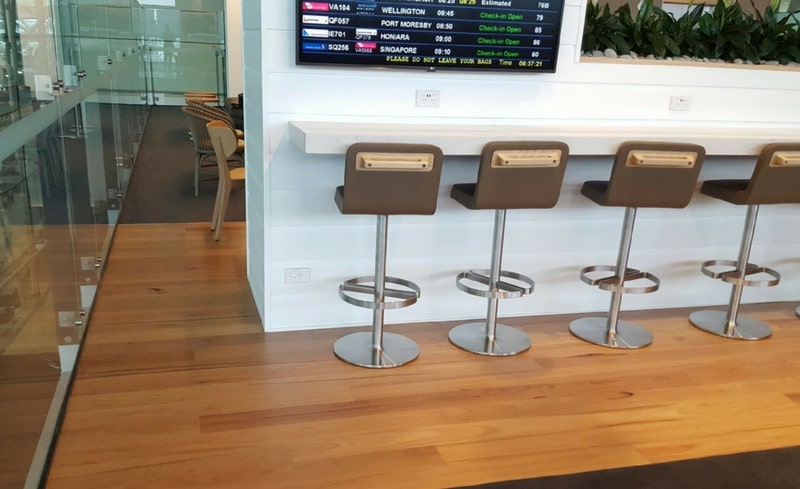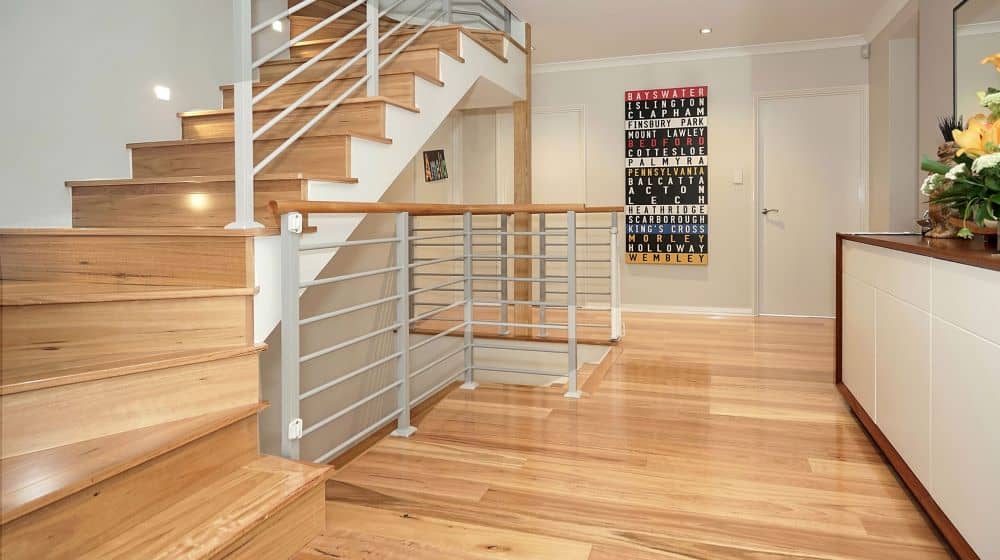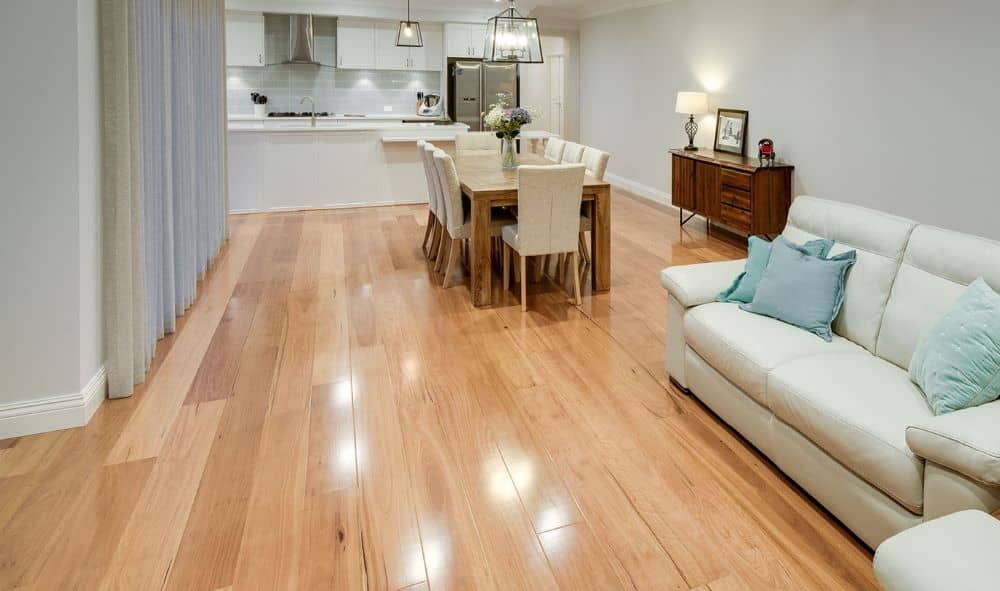As one of the most important hardwood species in the Australian landscape, it is no surprise that Blackbutt timber makes a popular choice for flooring. With a timeless look, durability, and warm beauty, Blackbutt timber is equally stunning and functional.
We’ve put together a complete guide to Australian Blackbutt Timber floors, including a list of frequently asked questions, to help you decide if Blackbutt flooring is right for you.
Quick Facts
- Botanical Name – Eucalyptus pilularis
- Janka Hardness – 9.1 (The Janka Hardness scale is an industry-based test that ranks the strength and durability of a wood species. Essentially, the higher the number, the stronger the flooring. A rating of 8+ is a good indication of hardness and strength.)
- Height – Grows up to 50 metres tall
- Appearance – Dark, glossy green leaves and white flowers in spring and summer
- Interesting Fact – Its leaves are a food source for koala bears
- Growth Rate – Relatively quick growing
What Is A Blackbutt Tree?
As one of the most popular Australian timber species used for flooring, Blackbutt trees are known for their towering height, unique appearance, and strength.
With its straight, aesthetically appealing gum veins, even texture, and sturdy, cylindrical trunks, Blackbutt timber is well-suited for use as a flooring material.
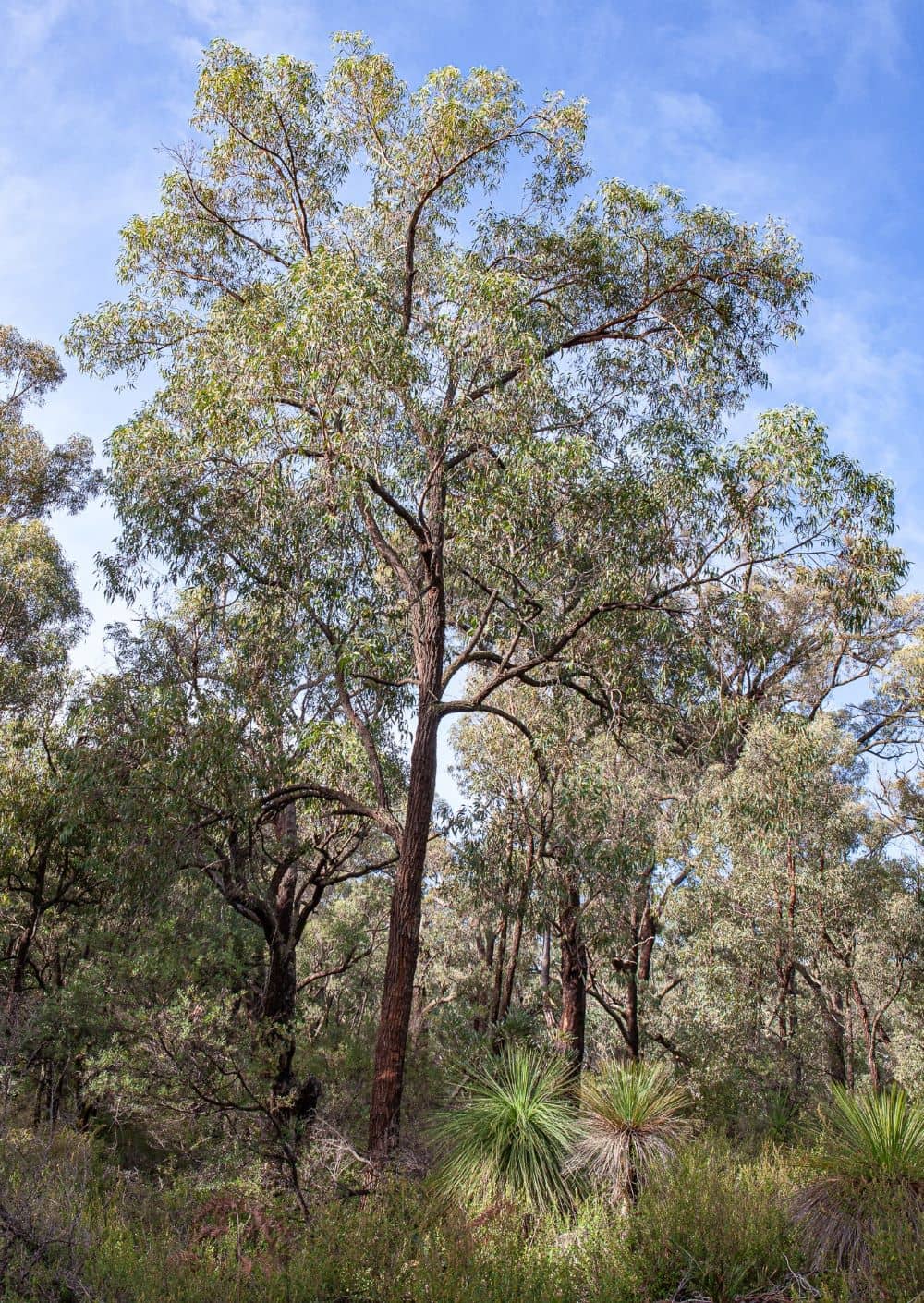
Australian Blackbutt tree.
How Did Australian Blackbutt Get Its Name?
Blackbutt gets its name due to the rough bark on the lower trunk, often charred black from past bush fires, and the smooth, lighter coloured upper trunk and branches. Old bark shreds off in strips, revealing the light white/yellowish coloured bark beneath.
Where Does The Timber Come From?
Blackbutt timber typically grows along the coastal regions of New South Wales and Queensland. is typically grown in the coastal regions of Queensland and New South Wales.
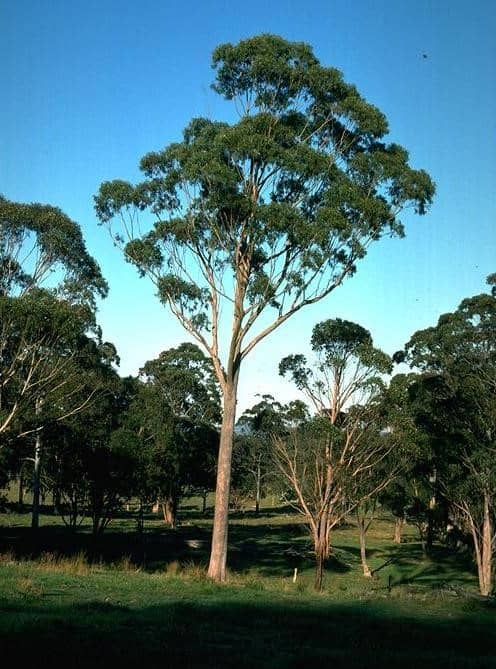
New England Blackbutt, a tree native to New South Wales and Queensland.
Is Blackbutt Classified as Hardwood or Softwood?
Blackbutt is classified as a hardwood. Hardwood trees tend to be fairly slow-growing, resulting in wood that is dense and strong. Blackbutt tends to reach maturity faster than other hardwood varieties while still producing strong wood.
What Colour Is Blackbutt Timber?
Despite having ‘black’ in its name, Blackbutt is a lighter timber shade. While actual Blackbutt trees are dark at the base of the trunk and lighter at the top, its timber ranges in colour from golden blonde to pale brown when milled. Its neutral tones effortless complement any colour scheme.
As Blackbutt is a natural, Australian-grown species, colours vary among products. For instance, timber from the tree’s centre — heartwood — will have warmer hues with an occasional hint of pink. Sapwood, timber from the tree’s outer portion, has small gum veins caused by the buildup of sap in the tree.
Another distinction depends on whether the timber is grown on a plantation or in the wild. Plantation-grown trees typically have fewer colour variations than their wild-grown counterparts.
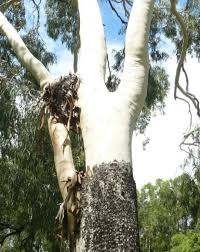
Eucalyptus Pilularis – barks peel away in strips during the summer months.
Typical Uses
Blackbutt timber is used for a wide variety of applications. It even serves as the flooring of Parliament House.
Because of its durability and strength, the majority of Blackbutt timber is used in construction work.
Aside from flooring, other uses of Blackbutt timber include:
- Railway sleepers
- Pulp
- Furniture
- Outdoor decking
- Framework
- Bridge planks
- Pool tables
- Paper
- Posts and poles
Benefits of Blackbutt Flooring?
With its smooth, flowing grain and versatility, Blackbutt is highly sought after by renovators and builders alike. Along with showcasing the beauty of the Australian bush, Blackbutt adds a natural earthiness, warmth, and luxury wherever it is used.
It is durable, low maintenance, and well-suited to the sometimes harsh climate conditions in Australia. No two pieces of Blackbutt timber are the same, making it a unique, show-stopping addition to any home.
Additionally, Blackbutt timber flooring is:
- Naturally termite resistant
- Naturally fire-resistant
- Very high density (900 kg / m3)
- Able to stand up to tough climate conditions
- Able to seamlessly complements a range of colour schemes and interior styles
- Highly resilient
- Extremely long-lasting when properly maintained
- Timeless in its appeal
But before you make blackbutt flooring the addition to your home, you need to keep in mind of its disadvantages as well.
Disadvantages of Blackbutt Timber Flooring
- Blackbutt flooring does not react well to adhesives and paints
- Bonding substances can leave stain marks on blackbutt flooring
- Painting blackbutt timber can lead to surface cracks
Uses in The Home
Its durable nature makes it an ideal choice for high-traffic areas while its raw beauty makes it a stunning addition to a variety of rooms in the home. It lends itself particularly well to airy spaces used for entertaining.
We particularly love Blackbutt flooring when used in:
- Living rooms
- Bedrooms
- Home offices
- Hallways
- Kitchens
When paired with indoor plants, lamps, and natural accents, it can create a sanctuary-like atmosphere right in your home.
As with other types of timber flooring, Blackbutt is not recommended as flooring in wet areas such as laundries or bathrooms.
If you live near a bushfire zone, Blackbutt timber is an excellent flooring material to consider. It is recognised and approved by the Building Commission in Victoria as a hardwood species that provide good fire resistance.
How Do I Clean Blackbutt Timber Flooring?
Blackbutt floors are extremely hard-wearing and easy to care for, with maintenance requirements similar to other types of timber flooring. Overall, regular sweeping and simple care is all it takes to keep Blackbutt looking its best.
Other tips for caring for Blackbutt flooring include:
- Avoid using chemical products or abrasive cleaners
- Check with the manufacturer to find suitable cleaning products
- Vacuum as needed
- Wipe up any spills immediately
- Use furniture protectors
- Declare your household a ‘shoes free’ zone
- For stains, use a well-wrung mop and appropriate, pH neutral, manufacturer-approved cleaner
How Durable Is Blackbutt Timber Flooring?
With an excellent 9.1 ranking on the Janka Scale, Blackbutt timber floors make an ideal choice for busy households or high traffic areas. When properly cared for and maintained, Blackbutt flooring can last for generations.
Can Blackbutt Timber Floors Be Re-Finished?
Blackbutt timber flooring can be sanded and re-finished if it starts to show signs of wear and tear, making it possible to last a lifetime.
Is Blackbutt Used in Other Types of Flooring?
Its coveted beauty makes Blackbutt the woodgrain of choice for other types of flooring materials including:
- Luxury vinyl
- Hybrid
- Engineered timber
- Laminate
Engineered timber floors feature an actual top layer of Blackbutt, while hybrid, vinyl, and laminate floors feature advanced digital imagery to mimic the appearance of Blackbutt timber.
Each flooring type offers unique pros and cons, which we cover extensively in our flooring comparison guides.
How Much Does Blackbutt Flooring Cost?
Blackbutt timber flooring costs more than most other hardwood flooring options, with costs depending on width and thickness.
Engineered Blackbutt features a real timber veneer over a plywood core, reducing the overall cost.
Synthetic options such as vinyl, hybrid, or laminate mimic the look of genuine Blackbutt timber flooring at a lower cost.
How Is Blackbutt Flooring Installed?
Blackbutt flooring installation depends on the type of flooring material chosen.
- Installing Solid Blackbutt Timber Floors – Solid Blackbutt timber flooring is installed directly over joists or adhered to existing floors.
Depending on the product and board width, it is generally installed using the glue and secret nail method where nails are inserted through the tongue of the planks at a 45-degree angle. This method creates a seamless appearance and further enhances Blackbutt’s appeal.
As with almost all flooring materials, we highly recommend utilising the expertise of a skilled tradesman for installation.
- Installing Other Types of Blackbutt Flooring – Laminate, hybrid, and engineered Blackbutt flooring can be installed as floating floors, depending on the condition of the subfloor and current flooring type.
Is Blackbutt Flooring Sustainable?
Blackbutt timber is considered sustainable as it is a species that regenerates easily and grows relatively quickly compared to other hardwood species. Also, the Australian government enforces logging regulations to protect and sustain Australian timber species.
Transform Your Home With Australian Blackbutt Timber Floors
Blackbutt flooring is a stunning way to add an Australian touch to your home and create a warm, inviting space with a timeless aesthetic appeal. We carry Australia’s most extensive range of flooring, including a beautiful variety of native Australian species such as Blackbutt.
If you would like to learn more about this high-performing, exquisite flooring choice, please feel free to get in touch with our friendly team of flooring experts. We welcome any flooring questions! We would be happy to help you determine if Australian Blackbutt timber floors would be a good match for your space, budget, design style, and needs.


